What is your hematocrit. Hematocrit Test: Understanding Your Red Blood Cell Count and Health Implications
What is hematocrit. How is the hematocrit test performed. Why might a healthcare provider recommend a hematocrit test. What do normal hematocrit results look like for different groups. What can abnormal hematocrit results indicate about a person’s health.
What is Hematocrit and Why is it Important?
Hematocrit is a crucial blood test that measures the percentage of red blood cells in a person’s blood volume. This measurement provides valuable insights into an individual’s overall health and can help diagnose various medical conditions. The hematocrit test, often abbreviated as HCT, is typically performed as part of a complete blood count (CBC).
Red blood cells play a vital role in the body’s functioning. They are responsible for:
- Transporting oxygen and nutrients to body tissues
- Removing waste and carbon dioxide
- Distributing hormones from endocrine organs to target tissues
- Maintaining body temperature and pH levels
- Assisting in clot formation and infection prevention
Given the importance of red blood cells, understanding one’s hematocrit level can provide critical information about overall health and potential underlying conditions.

The Hematocrit Test Procedure: What to Expect
The hematocrit test is a relatively simple and straightforward procedure. Here’s what you can expect:
- A healthcare professional will draw a blood sample, typically from a vein in your arm.
- The blood is collected in a small vial or test tube.
- The sample is then sent to a laboratory for analysis.
Is special preparation required for a hematocrit test? No special preparation is necessary. You can eat and drink normally before the test unless otherwise instructed by your healthcare provider.
During the blood draw, you may experience a brief moment of discomfort. Some individuals report feeling a moderate pain when the needle is inserted, while others describe it as a prick or stinging sensation. After the procedure, you might notice some throbbing or a slight bruise at the injection site, but this typically subsides quickly.
Reasons for Recommending a Hematocrit Test
Healthcare providers may recommend a hematocrit test for various reasons. Some common indications include:
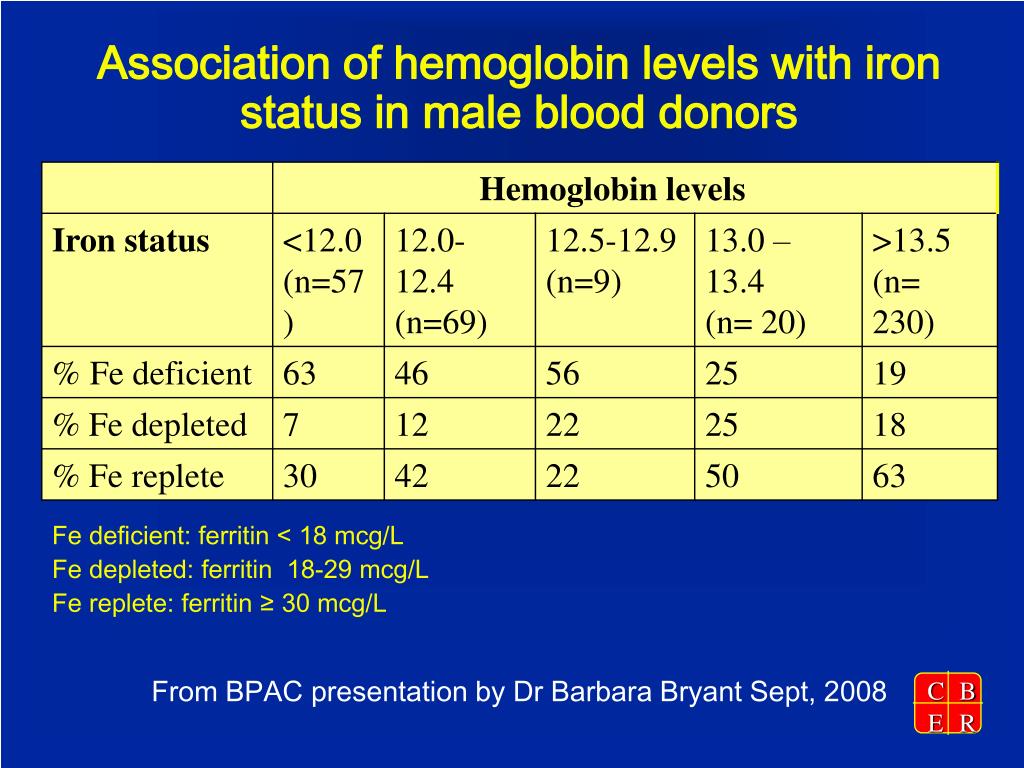
- Signs or risk factors for anemia
- Unexplained fatigue or weakness
- Chronic medical conditions (e.g., kidney disease, arthritis)
- Pregnancy monitoring
- Unexplained weight loss
- Persistent headaches
- Heavy menstrual periods
- Monitoring during cancer treatment
- Evaluation of medication side effects
- Assessment of nutritional status
- Difficulty concentrating
Additionally, hematocrit tests may be performed before and after major surgeries or in cases where there’s blood in the stool or vomit.
Understanding Hematocrit Results: Normal Ranges
Hematocrit results are typically expressed as a percentage of red blood cells in the total blood volume. Normal ranges can vary slightly between laboratories, but generally, they fall within the following parameters:
Adult Hematocrit Ranges
- Adult Males: 40.7% to 50.3%
- Adult Females: 36.1% to 44.3%
Pediatric Hematocrit Ranges
- Newborns: 45% to 61%
- Infants: 32% to 42%
It’s important to note that these ranges are general guidelines. Your healthcare provider will interpret your results in the context of your overall health, medical history, and other factors.
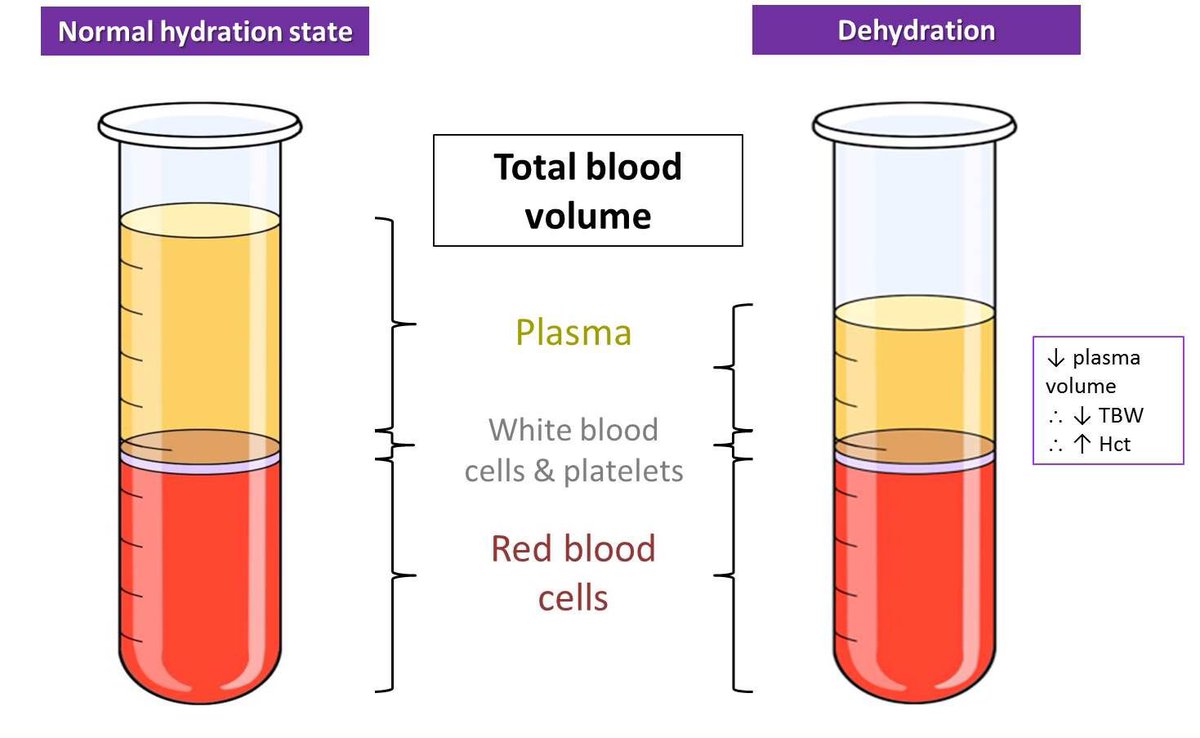
Interpreting Abnormal Hematocrit Results
Abnormal hematocrit results can indicate various health conditions. Let’s explore what low and high hematocrit levels might signify:
Low Hematocrit (Below Normal Range)
A lower-than-normal hematocrit may be indicative of:
- Anemia (various types)
- Recent or ongoing bleeding
- Bone marrow disorders affecting red blood cell production
- Chronic illnesses
- Chronic kidney disease
- Hemolysis (destruction of red blood cells)
- Leukemia or other cancers
- Malnutrition
- Nutritional deficiencies (iron, folate, vitamin B12, vitamin B6)
- Overhydration
High Hematocrit (Above Normal Range)
An elevated hematocrit level may suggest:
- Dehydration
- Polycythemia vera (a bone marrow disorder)
- Chronic obstructive pulmonary disease (COPD)
- Congenital heart disease
- High altitudes
- Smoking
Does a single abnormal hematocrit result always indicate a health problem? Not necessarily. Hematocrit levels can fluctuate due to various factors, including recent physical activity, hydration status, and even the time of day. Your healthcare provider will consider your results in conjunction with other tests and your overall health profile.

The Relationship Between Hematocrit and Hemoglobin
While hematocrit measures the percentage of red blood cells in blood volume, hemoglobin is the protein within red blood cells responsible for carrying oxygen. These two measurements are closely related and often reported together in blood tests.
How do hematocrit and hemoglobin levels correlate? Generally, hematocrit is about three times the hemoglobin value. For example, if a person’s hemoglobin is 15 g/dL, their hematocrit would be expected to be around 45%.
Both measurements provide valuable information about a person’s red blood cell status and oxygen-carrying capacity. Healthcare providers often use these values in tandem to diagnose and monitor various conditions, particularly anemia.
Factors Influencing Hematocrit Levels
Several factors can influence an individual’s hematocrit levels, including:
- Age and sex
- Altitude (higher altitudes typically result in higher hematocrit levels)
- Pregnancy (levels may decrease due to increased plasma volume)
- Hydration status
- Recent blood loss or transfusions
- Certain medications
- Smoking habits
- Chronic medical conditions
Understanding these influencing factors is crucial for accurately interpreting hematocrit results and determining appropriate follow-up actions or treatments.

Hematocrit Testing: Beyond Anemia Diagnosis
While hematocrit testing is commonly associated with anemia diagnosis, its applications extend far beyond this single condition. Hematocrit levels can provide insights into various aspects of health and disease:
Cardiovascular Health
Elevated hematocrit levels may indicate an increased risk of cardiovascular events. How does this correlation work? Higher hematocrit levels can increase blood viscosity, potentially leading to increased strain on the heart and blood vessels.
Athletic Performance
Athletes and their trainers often monitor hematocrit levels as part of performance optimization strategies. Why is this important? Higher hematocrit levels (within normal ranges) can improve oxygen delivery to muscles, potentially enhancing endurance and performance.
Altitude Adaptation
Individuals living at or traveling to high altitudes may experience changes in their hematocrit levels. The body naturally increases red blood cell production to compensate for lower oxygen levels at higher elevations.
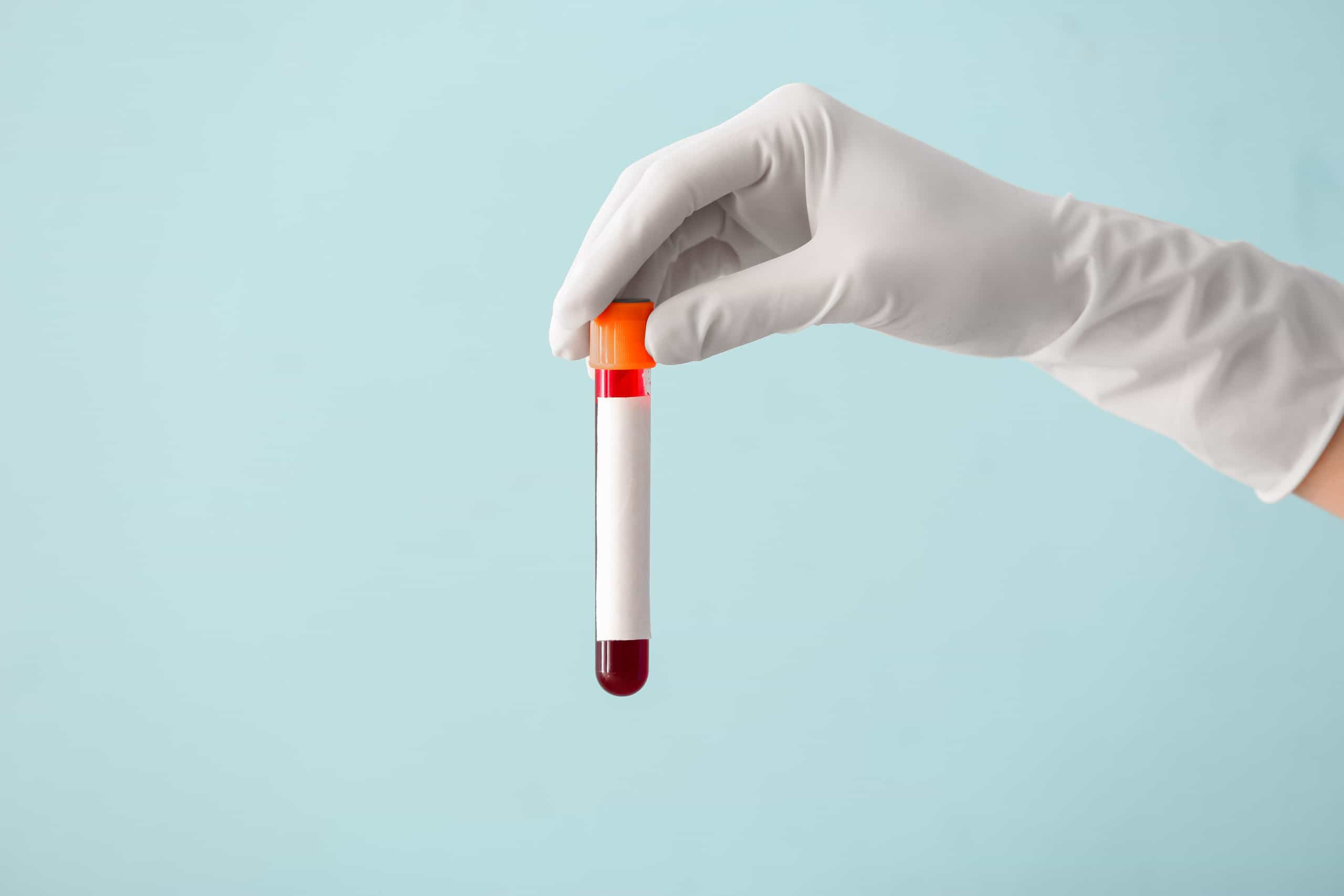
Pregnancy Monitoring
Hematocrit testing is a routine part of prenatal care. During pregnancy, a woman’s blood volume increases, which can lead to a relative decrease in hematocrit levels. Monitoring these changes helps ensure both maternal and fetal well-being.
Chronic Disease Management
For patients with chronic conditions such as kidney disease or certain types of cancer, regular hematocrit testing can help monitor disease progression and treatment efficacy.
By considering hematocrit levels in these broader contexts, healthcare providers can gain a more comprehensive understanding of a patient’s overall health status and tailor treatment plans accordingly.
Hematocrit and Blood Disorders: A Closer Look
Hematocrit testing plays a crucial role in the diagnosis and management of various blood disorders. Let’s explore some of these conditions in more detail:
Polycythemia Vera
Polycythemia vera is a rare blood cancer where the bone marrow produces too many red blood cells. How does hematocrit testing help in diagnosing this condition? Consistently elevated hematocrit levels, often above 52% in men and 48% in women, can be a key indicator of polycythemia vera.

Thalassemia
Thalassemia is an inherited blood disorder characterized by abnormal hemoglobin production. Individuals with thalassemia often have lower hematocrit levels, which can help in diagnosis and monitoring of the condition.
Sickle Cell Disease
In sickle cell disease, red blood cells are abnormally shaped, which can lead to various complications. Hematocrit levels in individuals with sickle cell disease are typically lower than normal and can fluctuate significantly during health crises.
Hemolytic Anemia
Hemolytic anemia occurs when red blood cells are destroyed faster than they can be replaced. This condition often results in lower hematocrit levels. Regular monitoring of hematocrit can help track the progression of the disease and the effectiveness of treatments.
Understanding the relationship between hematocrit levels and these blood disorders can aid in early detection, proper diagnosis, and effective management of these conditions.
Hematocrit and Nutrition: The Role of Diet
Nutrition plays a significant role in maintaining healthy hematocrit levels. Certain nutrients are essential for red blood cell production and function:
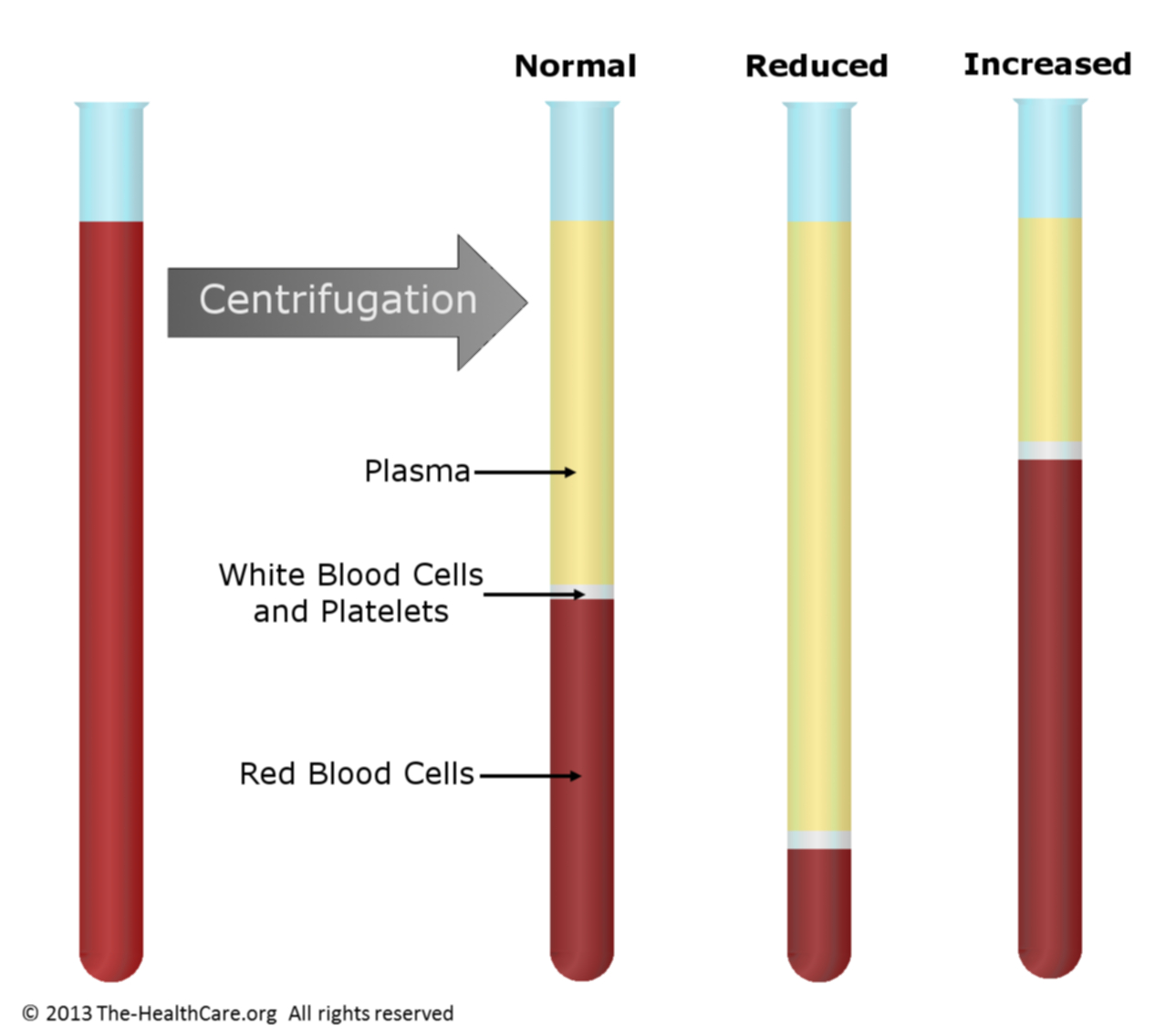
Iron
Iron is a crucial component of hemoglobin. Iron deficiency can lead to anemia and decreased hematocrit levels. What are good dietary sources of iron? Red meat, poultry, fish, beans, and fortified cereals are excellent sources of iron.
Vitamin B12
Vitamin B12 is necessary for red blood cell formation. A deficiency can result in megaloblastic anemia, characterized by larger but fewer red blood cells. Where can you find vitamin B12 in your diet? Animal products such as meat, fish, eggs, and dairy are rich in vitamin B12.
Folate
Folate, or vitamin B9, is essential for DNA synthesis and red blood cell production. Folate deficiency can lead to anemia and lower hematocrit levels. What foods are high in folate? Leafy green vegetables, legumes, and fortified grains are good sources of folate.
Vitamin C
While not directly involved in red blood cell production, vitamin C enhances iron absorption from plant-based sources. How can you incorporate vitamin C into your diet? Citrus fruits, berries, and bell peppers are excellent sources of vitamin C.

Maintaining a balanced diet rich in these nutrients can help support healthy hematocrit levels and overall blood health.
Hematocrit Testing in Clinical Practice: Beyond the Numbers
While hematocrit testing provides valuable numerical data, its interpretation and application in clinical practice extend far beyond these numbers. Healthcare providers consider various factors when evaluating hematocrit results:
Patient History
A patient’s medical history, including past illnesses, surgeries, and chronic conditions, can provide context for interpreting hematocrit results. How does this information influence interpretation? For example, a patient with a history of gastrointestinal bleeding might have lower hematocrit levels due to chronic blood loss.
Symptoms
The presence or absence of symptoms can help guide the interpretation of hematocrit results. What symptoms might be relevant? Fatigue, shortness of breath, or dizziness could indicate anemia, even if hematocrit levels are only slightly below normal.

Other Laboratory Tests
Hematocrit results are often interpreted in conjunction with other blood tests. How do these tests complement each other? For instance, examining red blood cell morphology can provide additional insights into the cause of abnormal hematocrit levels.
Trending
Monitoring hematocrit levels over time can reveal important patterns. Why is trending important? Gradual changes in hematocrit levels might indicate the progression of a chronic condition or the effectiveness of a treatment plan.
Individual Variation
It’s important to recognize that “normal” can vary from person to person. What might be considered a low hematocrit for one individual could be normal for another. Healthcare providers take these individual variations into account when interpreting results.
By considering these factors, healthcare providers can make more accurate diagnoses, develop appropriate treatment plans, and provide better overall care to their patients.
Future Directions in Hematocrit Testing and Research
As medical science advances, so does our understanding and application of hematocrit testing. Several exciting developments are on the horizon:

Point-of-Care Testing
Advancements in technology are making it possible to perform hematocrit tests quickly and easily at the point of care. How will this impact patient care? Rapid results can lead to faster diagnosis and treatment decisions, particularly in emergency situations.
Artificial Intelligence in Interpretation
Machine learning algorithms are being developed to assist in interpreting hematocrit results alongside other clinical data. What are the potential benefits of this approach? AI could help identify subtle patterns and correlations that might not be immediately apparent to human observers.
Personalized Medicine
As we gain a better understanding of individual variations in hematocrit levels, there’s potential for more personalized approaches to diagnosis and treatment. How might this change clinical practice? Treatment plans could be tailored based on an individual’s unique hematocrit profile and other health factors.
Non-Invasive Monitoring
Researchers are exploring non-invasive methods for monitoring hematocrit levels. What technologies are being investigated? Optical sensors and wearable devices show promise for continuous, pain-free hematocrit monitoring.

Expanded Applications
Ongoing research is uncovering new applications for hematocrit testing in various medical fields. For example, hematocrit levels are being studied as potential markers for cardiovascular risk and cognitive function in aging populations.
These advancements have the potential to enhance the utility of hematocrit testing, making it an even more valuable tool in healthcare. As research progresses, we can expect to see more precise, personalized, and accessible hematocrit testing methods in the future.
Hematocrit Information | Mount Sinai
HCT
Hematocrit is a blood test that measures how much of a person’s blood is made up of red blood cells. This measurement depends on the number of and size of the red blood cells.
Blood transports oxygen and nutrients to body tissues and returns waste and carbon dioxide. Blood distributes nearly everything that is carried from one area in the body to another place within the body. For example, blood transports hormones from endocrine organs to their target organs and tissues. Blood helps maintain body temperature and normal pH levels in body tissues. The protective functions of blood include clot formation and the prevention of infection.
For example, blood transports hormones from endocrine organs to their target organs and tissues. Blood helps maintain body temperature and normal pH levels in body tissues. The protective functions of blood include clot formation and the prevention of infection.
How the Test is Performed
A blood sample is needed.
How to Prepare for the Test
No special preparation is necessary for this test.
How the Test will Feel
When the needle is inserted to draw blood, some people feel moderate pain.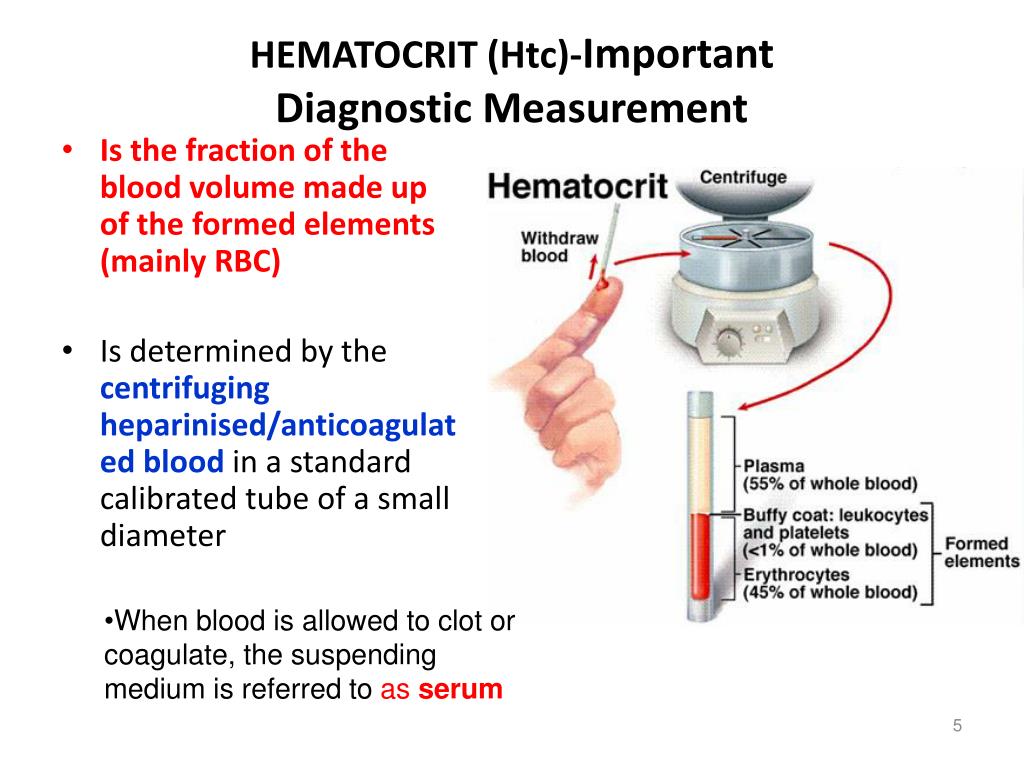 Others feel only a prick or stinging. Afterward, there may be some throbbing or a slight bruise. This soon goes away.
Others feel only a prick or stinging. Afterward, there may be some throbbing or a slight bruise. This soon goes away.
Why the Test is Performed
The hematocrit is almost always done as part of a complete blood count (CBC).
Your health care provider may recommend this test if you have signs of or are at risk for anemia. These include having:
- Before and after major surgery
- Blood in your stools, or vomit (if you throw up)
- Chronic medical problems, such as kidney disease or certain types of arthritis
- During pregnancy
- Fatigue, poor health, or unexplained weight loss
- Headaches
- Heavy menstrual periods
- Leukemia or other problems in the bone marrow
- Monitoring during treatment for cancer
- Monitoring medicines that may cause anemia or low blood counts
- Monitoring of anemia and its cause
- Poor nutrition
- Problems concentrating
Normal Results
Normal results vary, but in general they are:
- Male: 40.
 7% to 50.3%
7% to 50.3% - Female: 36.1% to 44.3%
For babies, normal results are:
- Newborn: 45% to 61%
- Infant: 32% to 42%
The examples above are common measurements for results of these tests. Normal value ranges vary slightly among different laboratories. Some labs use different measurements or test different samples. Talk to your provider about the meaning of your specific test results.
What Abnormal Results Mean
Low hematocrit may be due to:
- Anemia
- Bleeding
Bone marrow being unable to produce new red blood cells. This may be due to leukemia, other cancers, drug toxicity, radiation therapy, infection, or bone marrow disorders
- Chronic illness
- Chronic kidney disease
- Destruction of red blood cells (hemolysis)
- Leukemia
- Malnutrition
- Too little iron, folate, vitamin B12, and vitamin B6 in the diet
- Too much water in the body
High hematocrit may be due to:
- Bone marrow disease that causes abnormal increase in red blood cells (polycythemia vera)
- Congenital heart disease
- Exposure to high altitude
- Failure of the right side of the heart
- Low levels of oxygen in the blood
- Scarring or thickening of the lungs
- Too little water in the body (dehydration)
Risks
There is little risk involved with having your blood taken. Veins and arteries vary in size from one person to another and from one side of the body to the other. Obtaining a blood sample from some people may be more difficult than from others.
Veins and arteries vary in size from one person to another and from one side of the body to the other. Obtaining a blood sample from some people may be more difficult than from others.
Other risks associated with having blood drawn are slight but may include:
- Excessive bleeding
- Fainting or feeling lightheaded
- Multiple punctures to locate veins
- Hematoma (blood buildup under the skin)
- Infection (a slight risk any time the skin is broken)
Chernecky CC, Berger BJ. H. Hematocrit blood. In: Chernecky CC, Berger BJ, eds. Laboratory Tests and Diagnostic Procedures. 6th ed. St Louis, MO: Elsevier Saunders; 2013:620-621.
Kliegman RM, St. Geme JW, Blum NJ, Shah SS, Tasker RC, Wilson KM. Blood disorders. In: Kliegman RM, St. Geme JW, Blum NJ, Shah SS, Tasker RC, Wilson KM, eds. Nelson Textbook of Pediatrics. 21st ed. Philadelphia, PA: Elsevier; 2020:chap 124.
Nelson Textbook of Pediatrics. 21st ed. Philadelphia, PA: Elsevier; 2020:chap 124.
Means RT. Approach to the anemias. In: Goldman L, Schafer AI, eds. Goldman-Cecil Medicine. 26th ed. Philadelphia, PA: Elsevier; 2020:chap 149.
Vajpayee N, Graham SS, Bem S. Basic examination of blood and bone marrow. In: McPherson RA, Pincus MR, eds. Henry’s Clinical Diagnosis and Management by Laboratory Methods. 24th ed. Philadelphia, PA: Elsevier; 2022:chap 31.
Last reviewed on: 1/9/2022
Reviewed by: David C. Dugdale, III, MD, Professor of Medicine, Division of General Medicine, Department of Medicine, University of Washington School of Medicine. Also reviewed by David Zieve, MD, MHA, Medical Director, Brenda Conaway, Editorial Director, and the A.D.A.M. Editorial team.
Hematocrit | Sight Diagnostics
Definition, Test, Low vs High Levels and Causes
What is hematocrit
Hematocrit (HCT) is the calculated volume percentage of red blood cells (erythrocytes) in your blood.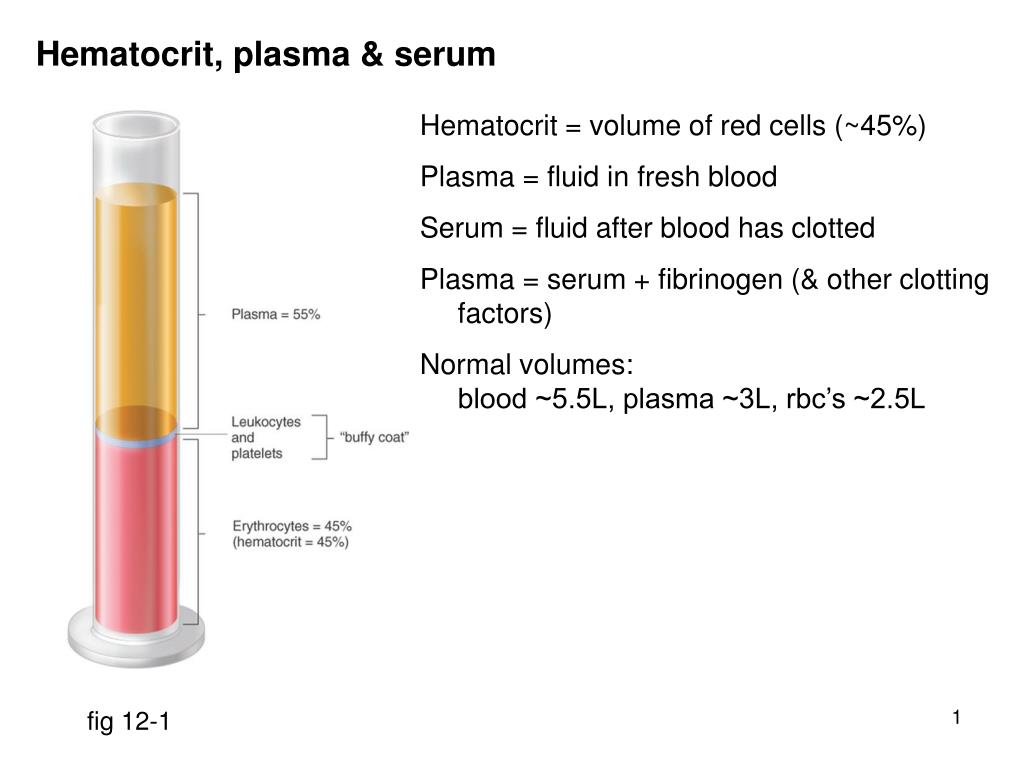 Hematocrit is also called packed cell volume (PCV) or erythrocyte volume fraction.
Hematocrit is also called packed cell volume (PCV) or erythrocyte volume fraction.
Human blood contains red blood cells, white blood cells, and platelets suspended in a liquid called plasma. The word hematocrit means to separate blood. In a hematocrit test, the red blood cells are separated from the rest of your blood cells and plasma.
Hematocrit is important because red blood cells are essential to your survival. They contain a vital protein component called hemoglobin that binds to oxygen, which fuels all the cells in your body.
When red blood cells pass through your lungs, they bind to and transport oxygen to various cells in your body. On their way back to your lungs, they carry carbon dioxide to be exhaled. Hematocrit is a significant measurement as it can identify whether you have sufficient red blood cells for oxygen transportation and delivery.
If your doctor suspects that you have a blood disorder such as anemia or polycythemia (too many red blood cells), your doctor may order a hematocrit test to check your red blood cells.
How to measure hematocrit with a test?
The original method for hematocrit measurement is the macrohematocrit (Wintrobe hematocrit tube) method.
It uses a narrow glass tube and a centrifuge machine. The centrifuge separates the blood into three main layers: red blood cells, white blood cells, and platelets, in that order from the bottom up. At the very top, there’s a small layer of blood plasma. The macrohematocrit method carries the risk of measuring trapped plasma as part of the red blood cell layer, which erroneously elevates the hematocrit percentage.[1]
A newer method is the microhematocrit method, which uses a capillary tube instead of a narrow glass tube and requires a smaller quantity of blood and less time. The microhematocrit method traps less plasma because the diameter of the capillary tube is smaller than the Wintrobe hematocrit tube. So the percentage of hematocrit is more accurate in the microhematocrit method than in the macrohematocrit method.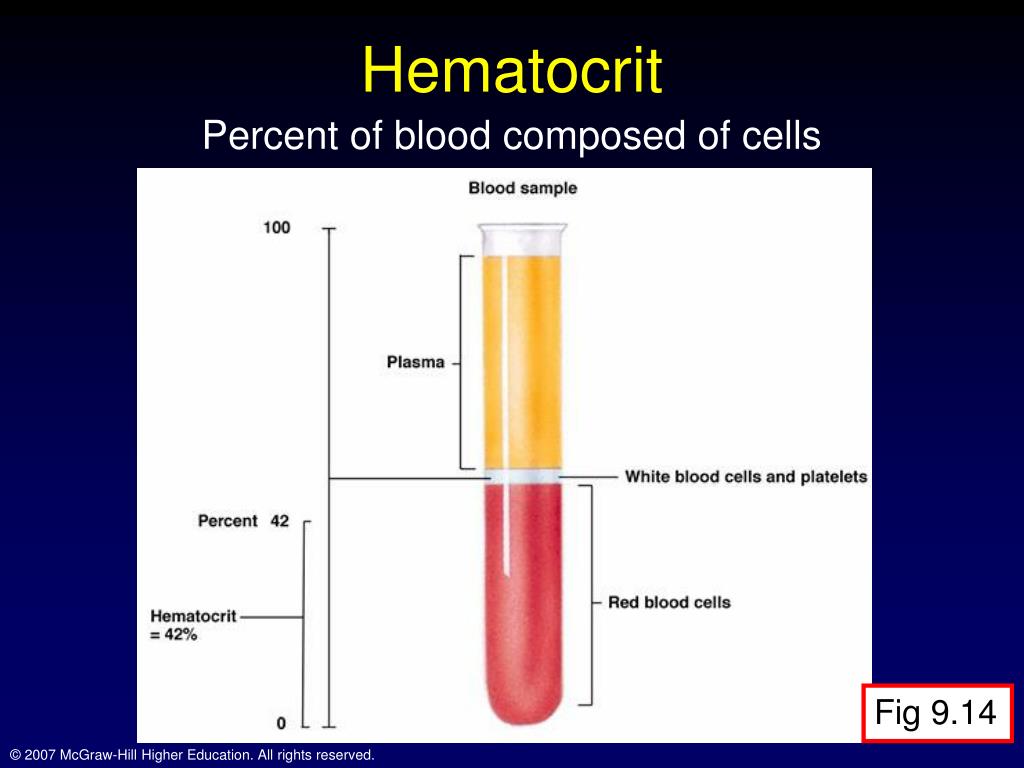 [1:1]
[1:1]
Both procedures require the technician to manually measure the length of the layers. The technician calculates hematocrit as the length of the packed red blood cell layer divided by the length of total cells and plasma. This ratio is then multiplied by 100 to give a certain percentage.
Today, these two methods have been largely succeeded by an automated hematology analyzer where the hematocrit test is obtained as part of a complete blood count (CBC) laboratory test. The hematocrit is calculated indirectly from the average volume and the number of red blood cells.[2] The automated analyzer is the fastest method. However, automated analyzers may not be available in areas where resources are low.
In the microhematocrit method, a technician only needs a small sample of blood from a finger-prick. In the other methods, the technician draws blood from the inner side of your arm or the back of your hand. Before drawing blood for the measurement, the technician first cleans the surface from where your blood would be drawn. Next, using a needle, the technician draws your blood. Afterward, the technician covers the surface with gauze and a bandage.
Next, using a needle, the technician draws your blood. Afterward, the technician covers the surface with gauze and a bandage.
What is a normal hematocrit level?
Due to differences in age and gender, the normal hematocrit is a range. Hematocrit results are reported as a percentage. The average hematocrit measurement for human beings is 45%, which means that the red cell volume contains 45 mL per 100 mL of blood.[3]
According to the Cleveland clinic, the general normal ranges for hematocrit are[4]:
- Male: 41% to 50%
- Female: 36% to 44%
- Newborn: 45% to 61%
- Infant: 32% to 42%
What does it mean if your hematocrit is high?
If your hematocrit is high, it means that you have more red blood cells than is considered healthy.
High hematocrit may be caused by [4:1]:
- Heart disease
- Dehydration
- Scarring or thickening of the lungs
- Bone marrow disease
- Obstructive sleep apnea
- Smoking and chronic obstructive pulmonary disease (COPD)
- Carbon monoxide poisoning
- Testosterone use
A false high hematocrit may be reported if the patient has cryoproteins, significant leukocytosis, or giant platelets.:max_bytes(150000):strip_icc()/hemoglobin-level-5211543-DD_Final-5839bd4fad49464584cc69c5460cb0eb.jpg) Hematocrit measurement is critically high if it is greater than 67% (>67%).
Hematocrit measurement is critically high if it is greater than 67% (>67%).
What does it mean if your hematocrit is low?
If your hematocrit is low, it means that you have fewer red blood cells than is considered healthy.
Low hematocrit may be caused by[4:2]:
- Blood loss
- Leukemia or other bone marrow problems
- Iron and vitamin deficiency, including folate, vitamin B12, and vitamin B6
- Too much water in the body
- Kidney disease
- Thyroid abnormality
- Immune destruction of red blood cells
A false low hematocrit may be reported if the patient has microcytosis, in vitro hemolysis, or autoagglutinins. Hematocrit is considered critically low if it falls below 21% (<21%).
How to increase hematocrit?
In some cases, hematocrit is caused because of low iron levels. You can eat iron-rich foods and take a daily vitamin supplement to help prevent low hematocrit causes.
Food sources that are rich in iron include:
- Red meat
- Beef liver
- Chicken liver
- Fish and shellfish
- Soy products (tofu and edamame)
- Dried fruit
- Green leafy vegetables
- Nuts
- Beans
- Iron-fortified bread and cereals
- Eggs
Additionally, vitamin C helps with iron absorption. Therefore, also eat various foods that are rich in vitamin C, for example, citrus fruits. Do not drink coffee or tea with your meals because this decreases iron absorption.
Therefore, also eat various foods that are rich in vitamin C, for example, citrus fruits. Do not drink coffee or tea with your meals because this decreases iron absorption.
Discover Sight’s Automated Hematology Analyzer
Related posts
Giant Platelets
Eosinophils
Cyclic Neutropenia
Question-answer on the topic “Male menopause, andropause”
Questions found: 6
- Question: #81664
- Asks:
Paul
( Volzhsky ) - 04/22/2021
- 12:04
- Hello! For the first time in my life I passed tests for hormones, I would like to know what could be wrong in my 63 years.
 Could you look at what should be paid attention to, and if something is wrong, please advise how to fix it, maybe what to drink or pierce? Thank you very much!
Could you look at what should be paid attention to, and if something is wrong, please advise how to fix it, maybe what to drink or pierce? Thank you very much!Gender male
Age 63g
Height 170
Weight 63kgFasting venous blood test
Glucose 6.10 mmol/l reference 4.60-6.40
Testosterone total 18.890 nmol/l reference 7.660-24.820
Testosterone free 0.2916 nmol/l reference 0.2188-0.7708
Luteinizing hormone (LH) 2.51mIU/ml reference 0.57-12.07
Estradiol 74.0 pmol/l reference 40.37-161.48
Free androgen index 35.4% referent 19.3 -118.4
Sex hormone binding globulin 53.4 nmol/l reference 13.7-69.9
- Answers:
Plekhanov Aleksey Yuryevich ( Head of the urological department of Andros Clinic, urologist, PhD)
- Your sex hormones are all right.

- Question: #80549
- Asks:
Anton
( St. Petersburg ) - 08/27/2019
- 21:08
- Hello, my testosterone dropped in a year. Last autumn it was 14.68 nmol/l, in April it was already 8.2 nmol/l, and in August it was 6.9 nmol/l.
All other hormones are normal (LH, FSL, hCG too), sugar is normal.
There were no injuries and illnesses, the weight did not increase (but it has been above the norm since childhood). Hair does not fall out and has grown everywhere where it shouldI’m afraid it’s hypogonadism and that I’m infertile
- Answers:
Plekhanov Aleksey Yuryevich ( Head of the urological department of Andros Clinic, urologist, PhD)
- Come with the results of previously conducted examinations to my appointment, I will try to figure it out and help.
 Appointment by phone and St. Petersburg 235-1487.
Appointment by phone and St. Petersburg 235-1487.
- Question: #80193
- Asks:
Andrey
- 01/24/2019
- 14:01
- To question #80183 – FSH did not pass, total testosterone 295 ng / dl (norm 166-1138), LH 2.43mIU / ml (norm 1.14 – 8.75), estradiol 28pg / ml (norm 11 – 44). TSH, ST3, PRL – strictly in the middle. I am 28 years old, I am actively engaged in the gym, I rarely drink alcohol, I get enough sleep, I do not smoke. A familiar general practitioner who advised me to take it all says that at my age and with my activity and occupation in the gym, the testosterone level should be much higher and said that I have secondary hypogonadism. I took tests at 9-10 in the morning, having slept, before that 3 days without physical exertion and alcohol.
 Haven’t eaten in 12 hours, haven’t had sex in 24 hours.
Haven’t eaten in 12 hours, haven’t had sex in 24 hours.
Thank you in advance.
- Answers:
Plekhanov Aleksey Yuryevich ( Head of the urological department of Andros Clinic, urologist, PhD)
- Testosterone concentration 295 ng/dl = 10.2 nmol/l. The norm is considered to be 12.1 nmol / l and above. Repeat the test for testosterone, in addition, take a blood test for SHBG and albumin, and of FSH. Get the result – signal.
- Question: #80138
- Asks:
Andrey
( Russia ) - 12/23/2018
- 19:12
- Hello! I am 42 years old.
 I have been on HRT for 1.5 years with Nebido. According to the tests, testosterone keeps 25-27 nmol all the time. ).According to the results of the KLA, a high hematocrit of 52% was found out. The doctor advised me to drink more fluid. I brought it to 3.5 liters per day. The situation improved for a short time. to do, the hematologist suggests, but does not insist on bloodletting. What do you advise?
I have been on HRT for 1.5 years with Nebido. According to the tests, testosterone keeps 25-27 nmol all the time. ).According to the results of the KLA, a high hematocrit of 52% was found out. The doctor advised me to drink more fluid. I brought it to 3.5 liters per day. The situation improved for a short time. to do, the hematologist suggests, but does not insist on bloodletting. What do you advise?
- Answers:
Plekhanov Aleksey Yuryevich ( Head of the urological department of Andros Clinic, urologist, PhD)
- An increase in the number of red blood cells and an increase in hematocrit is a consequence of hormone replacement therapy with testosterone preparations. Therefore, you have two options for solving this problem: a) stop the testosterone preparations or b) do something with the blood, reducing the number of red blood cells.
 The variant with bloodletting, proposed by the hematologist, has the right to life in the form of simple bloodletting or blood donation.
The variant with bloodletting, proposed by the hematologist, has the right to life in the form of simple bloodletting or blood donation.
- Question: #80130
- Asks:
Alexander
( Zaporozhye, Ukraine ) - 12/21/2018
- 23:12
- Good evening. Doctor, please tell me: after the removal of the testicle, testosterone dropped to 3.8. Three weeks have passed since the operation. The second testicle is hypoplastic. What drug to inject to increase testosterone and how often? Thanks in advance for the answer.
- Answers:
Plekhanov Aleksey Yuryevich ( Head of the urological department of Andros Clinic, urologist, PhD)
- Testosterone 3.
 8 in what units of measurement: ng/ml, ng/dl or nmol/l?
8 in what units of measurement: ng/ml, ng/dl or nmol/l?
- Question: #79450
- Asks:
Alexei
( Voronezh ) - 05/31/2018
- 13:05
- Hello, tell me if total testosterone can be normal and free testosterone is not
- Answers:
Plekhanov Aleksey Yuryevich ( Head of the urological department of Andros Clinic, urologist, PhD)
- The most accurate way to determine free testosterone (according to ISSAM) is to recalculate using sex hormone-binding globulin and albumin concentrations.
 When the concentration of total testosterone is above 12.1 nmol / l, as a rule, the concentration of free testosterone is normal and does not require determination. If you have clinical manifestations of hypogonadism, take a blood test in the morning before 10:00 am for total testosterone, SHBG, albumin – the result will allow you to easily calculate the desired concentration of free testosterone.
When the concentration of total testosterone is above 12.1 nmol / l, as a rule, the concentration of free testosterone is normal and does not require determination. If you have clinical manifestations of hypogonadism, take a blood test in the morning before 10:00 am for total testosterone, SHBG, albumin – the result will allow you to easily calculate the desired concentration of free testosterone.
What you can learn from a routine blood test
Expert quality. Fast. Comfortable. No queue.
Having studied your analysis, you should not immediately sound the alarm and run to all conceivable and unthinkable specialists. Remember that the doctor focuses not only on laboratory tests, but also on your condition, complaints, and examination data. Any indicator may not fit into the norm for a variety of reasons, starting with improper sampling of material and ending with your usual excitement when taking an analysis.+measures+how+much+space+in+the+blood+is+occupied+by+red+blood+cells..jpg)
Moms and dads should also pay attention to the fact that normal blood counts in children change with age and can be normal for a child with an increased or decreased value for an adult.
Blood test in Krasnoyarsk
You can take a clinical blood test in Krasnoyarsk at Arnika Family Clinic on all days of the week, except Sunday. Our clinic provides an opportunity to take a blood test at home. Call 234-55-55 to send a nurse to your home.
The average blood volume in an adult is 4-6 liters. Plasma accounts for about 55% of them, and 44% for erythrocytes. One cubic millimeter of blood contains about 3.7-5,000,000 erythrocytes (in terms of a liter 3.7-5×1012), the number of erythrocytes is one of the first indicators of blood .
The second determined indicator is hemoglobin (Hb) , it is located in the erythrocyte and carries out the transfer of oxygen to tissues and carbon dioxide in the opposite direction. The average norms of Hb are 115-160 g / l. A decrease in the number of red blood cells and hemoglobin is exactly the condition that is called anemia. A significant decrease in the number of red blood cells by 4-5 times can occur with leukemia and metastases of malignant tumors. An increase in the number of erythrocytes (erythrocytosis) may be associated with a disease of the blood system, or may be a consequence of oxygen starvation of tissues, for example, with congenital heart defects, with pulmonary diseases, and with smoking.
The average norms of Hb are 115-160 g / l. A decrease in the number of red blood cells and hemoglobin is exactly the condition that is called anemia. A significant decrease in the number of red blood cells by 4-5 times can occur with leukemia and metastases of malignant tumors. An increase in the number of erythrocytes (erythrocytosis) may be associated with a disease of the blood system, or may be a consequence of oxygen starvation of tissues, for example, with congenital heart defects, with pulmonary diseases, and with smoking.
Hematocrit (Ht) determines the ratio of plasma volume and blood cells, averages 36-54%.
Color index (CPI) shows the relative content of hemoglobin in the erythrocyte. Its normal values are 0.86-1.05.
Reticulocytes (Rt) are newly formed red blood cells. Their norm is 0.5-0.15% of the total number of red blood cells. An increase in their number can be observed with blood loss, in the treatment of anemia (as a criterion for proper treatment). A decrease in the number of reticulocytes can be observed with anemia, when taking cytostatic drugs, radiation sickness.
A decrease in the number of reticulocytes can be observed with anemia, when taking cytostatic drugs, radiation sickness.
ESR (erythrocyte sedimentation rate)
Norm 1-15 mm/hour. An increase in ESR may indicate various acute and chronic inflammatory processes, and may also occur with myocardial infarction, tumors, after blood loss, surgical interventions, with a reduced number of red blood cells in the blood. Especially actively it increases with blood diseases, malignant neoplasms, chronic hepatitis, cirrhosis of the liver, tuberculosis and other diseases. The decrease can be with viral hepatitis, jaundice, taking salicylates, calcium chloride.
Platelets (Tr)
The main function of these blood elements is participation in blood coagulation. Their normal amount is 200-400×109 / l. An increase in the amount of Tr can be in various diseases associated with a violation of the formation of platelets, in chronic diseases, such as: rheumatoid arthritis, tuberculosis, sarcoidosis, colitis, enteritis.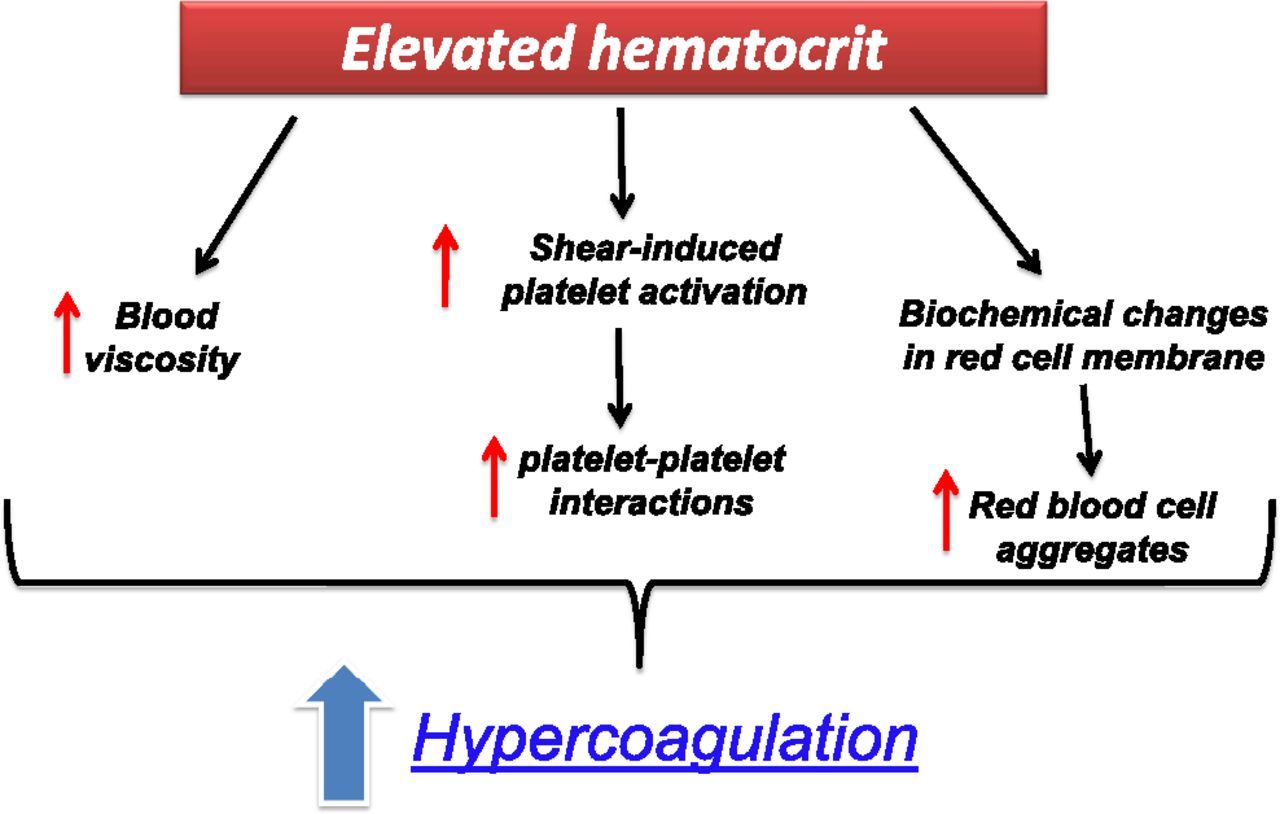 And also in acute diseases: bleeding, anemia, burns, blood loss, muscle injury, etc. Normally, an increase in the amount of Tr can occur in athletes and people engaged in heavy physical labor. A decrease in the Tr number is observed in blood diseases, alcoholism, as a possible reaction to drugs.
And also in acute diseases: bleeding, anemia, burns, blood loss, muscle injury, etc. Normally, an increase in the amount of Tr can occur in athletes and people engaged in heavy physical labor. A decrease in the Tr number is observed in blood diseases, alcoholism, as a possible reaction to drugs.
Leukocytes
Their normal amount is 4-9 x 109 / l. The increase in the number of leukocytes may be physiological, i.e. typical for a healthy person, for example, after eating (up to 10-12×109), after physical work, taking hot and cold baths, during pregnancy, childbirth, during the premenstrual period. A pathological increase in the L number can occur in various inflammatory processes, infarctions of various organs (myocardium, lungs, spleen, kidneys), extensive burns, malignant diseases, diseases of the blood system, extensive blood loss and other processes. A decrease in the number L can be with diseases of the spleen, exposure to radiation, taking certain medications, with diseases of the thyroid gland, with a number of infectious diseases, incl. with rubella, measles, influenza, viral hepatitis, etc.
with rubella, measles, influenza, viral hepatitis, etc.
Leukocytes in percentage terms are divided into: basophils (0.5-1%), eosinophils (0.5-5%), neutrophils (stab 1-6%, segmented -47-72%), lymphocytes (19-37 %), monocytes (3-11%).
The main function of neutrophilic granulocytes is to detect, capture and digest foreign material. An increase in their number can be with acute inflammatory diseases, intoxication, myocardial infarction, etc. A decrease in their number is noted with anemia, viral infections.
Eosinophils
An increase in the number of eosinophils can be due to allergic reactions, bronchial asthma, helminthiases, tumors, scarlet fever, taking certain drugs, etc.
Basophils
Their main function is participation in immunological reactions. An increase in their number is rare.
Monocytes
They circulate in the blood, and then pass into the tissues, turning into macrophages.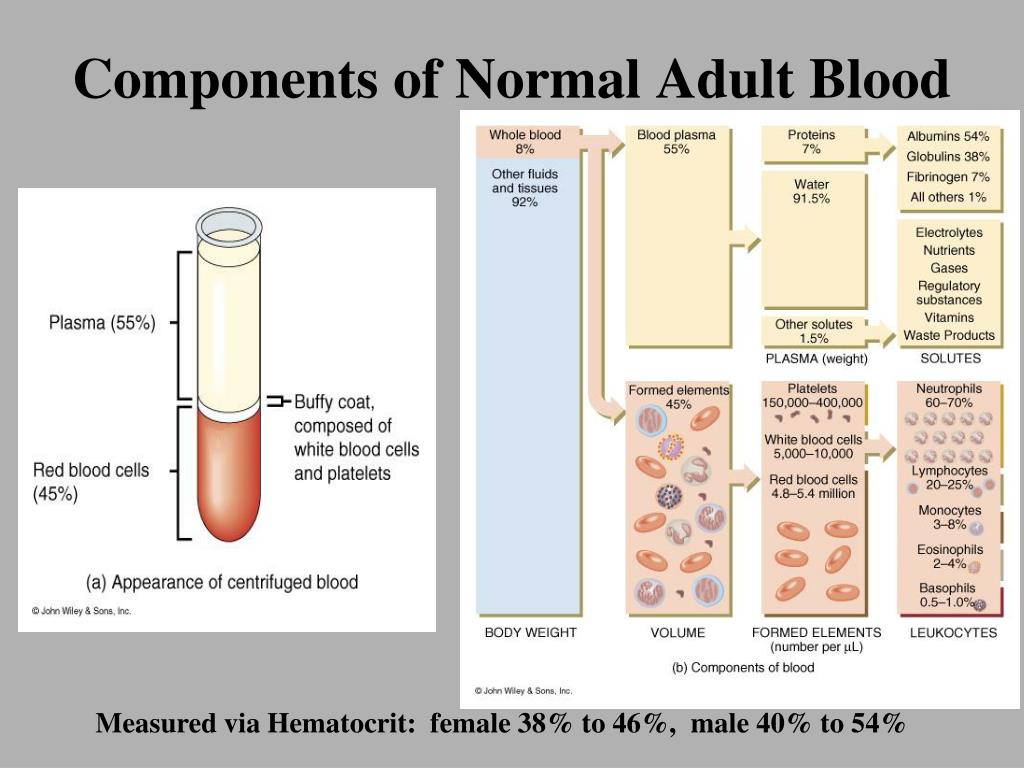 An increased number of monocytes is characteristic of tuberculosis, syphilis, brucellosis, protozoal and viral diseases (rubella, scarlet fever, mumps, mononucleosis).
An increased number of monocytes is characteristic of tuberculosis, syphilis, brucellosis, protozoal and viral diseases (rubella, scarlet fever, mumps, mononucleosis).
Lymphocytes
An increase in the number of lymphocytes is observed in whooping cough, infectious mononucleosis, chickenpox, rubella in diseases of the blood system, bronchial asthma, thyrotoxicosis, tuberculosis, drug use, diabetes, etc.
4
All medical tests are examined in the Arnika Family Clinic’s own laboratory – no risks associated with transportation. The technology of sampling, storage, processing of laboratory tests is debugged to the smallest detail. An extract of the results is performed by qualified doctors! Doctors from other clinics and experts trust us.
Donate blood for general analysis in Krasnoyarsk.
Phone for consultation 234-55-55
You can take any type of analysis in Krasnoyarsk.

 7% to 50.3%
7% to 50.3% Could you look at what should be paid attention to, and if something is wrong, please advise how to fix it, maybe what to drink or pierce? Thank you very much!
Could you look at what should be paid attention to, and if something is wrong, please advise how to fix it, maybe what to drink or pierce? Thank you very much!
 Appointment by phone and St. Petersburg 235-1487.
Appointment by phone and St. Petersburg 235-1487. Haven’t eaten in 12 hours, haven’t had sex in 24 hours.
Haven’t eaten in 12 hours, haven’t had sex in 24 hours.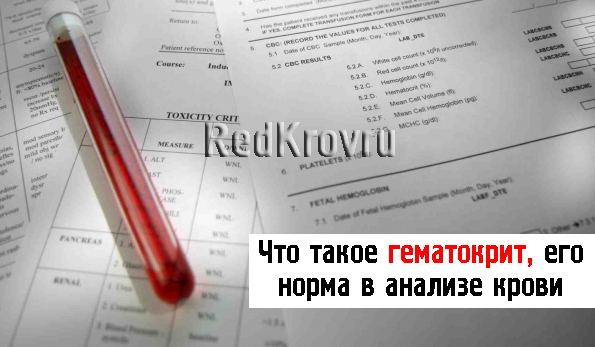 I have been on HRT for 1.5 years with Nebido. According to the tests, testosterone keeps 25-27 nmol all the time. ).According to the results of the KLA, a high hematocrit of 52% was found out. The doctor advised me to drink more fluid. I brought it to 3.5 liters per day. The situation improved for a short time. to do, the hematologist suggests, but does not insist on bloodletting. What do you advise?
I have been on HRT for 1.5 years with Nebido. According to the tests, testosterone keeps 25-27 nmol all the time. ).According to the results of the KLA, a high hematocrit of 52% was found out. The doctor advised me to drink more fluid. I brought it to 3.5 liters per day. The situation improved for a short time. to do, the hematologist suggests, but does not insist on bloodletting. What do you advise? The variant with bloodletting, proposed by the hematologist, has the right to life in the form of simple bloodletting or blood donation.
The variant with bloodletting, proposed by the hematologist, has the right to life in the form of simple bloodletting or blood donation. 8 in what units of measurement: ng/ml, ng/dl or nmol/l?
8 in what units of measurement: ng/ml, ng/dl or nmol/l? When the concentration of total testosterone is above 12.1 nmol / l, as a rule, the concentration of free testosterone is normal and does not require determination. If you have clinical manifestations of hypogonadism, take a blood test in the morning before 10:00 am for total testosterone, SHBG, albumin – the result will allow you to easily calculate the desired concentration of free testosterone.
When the concentration of total testosterone is above 12.1 nmol / l, as a rule, the concentration of free testosterone is normal and does not require determination. If you have clinical manifestations of hypogonadism, take a blood test in the morning before 10:00 am for total testosterone, SHBG, albumin – the result will allow you to easily calculate the desired concentration of free testosterone.